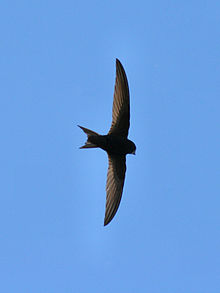Swift
| Swifts | |
|---|---|
 | |
| Common Swift, Apus apus Note wing shape different from swallows | |
| Scientific classification | |
| Kingdom: | Animalia |
| Phylum: | Chordata |
| Class: | Aves |
| Order: | Apodiformes |
| Family: | Apodidae Hartert, 1897 |
| Genera | |
Nearly 20, see text.
| |
The swifts are a family, Apodidae, of highly aerial birds. They are superficially similar to swallows, but are actually not closely related to passerine species at all; swifts are in the separate order Apodiformes, which they share with hummingbirds. The treeswifts are closely related to the true swifts, but form a separate family, the Hemiprocnidae.
The resemblances between swifts and swallows are due to convergent evolution, reflecting similar life styles based on catching insects in flight.
The family scientific name comes from the Ancient Greek απους, apous, meaning "without feet", since swifts have very short legs and never settle voluntarily on the ground, clinging instead to vertical surfaces. The tradition of depicting swifts without feet continued into the Middle Ages, as seen in the heraldic martlet.
Description
Swifts are the most aerial of birds. Larger species are amongst the fastest fliers in the animal kingdom, with the White-throated Needletail having been reported flying at up to 169km/h. Even the Common Swift cruises at 5 to 14 metres per second (18–50 km/h, 11–31 mph).In a single year the common swift can cover at least 200,000 km.
The swiftlets or cave swiftlets have developed a form of echolocation for navigating through dark cave systems where they roost. One species, Aerodramus papuensis, has recently been discovered to use this navigation at night outside its cave roost also.
Swifts occur on all the continents, though not in the far north or large deserts, and on many oceanic islands.Like swallows and martins, the swifts of temperate regions are strongly migratory and winter in the tropics. Some species can survive short periods of cold weather by entering torpor, a state similar to hibernation.
Many have a characteristic shape, with a short forked tail and very long swept-back wings that resemble a crescent or a boomerang. The flight of some species is characterised by a distinctive "flicking" action quite different from swallows. Swifts range in size from the Pygmy Swiftlet (Collocalia troglodytes), which weighs 5.4 g and measures 9 cm (3.7 inches) long, to the Purple Needletail (Hirundapus celebensis), which weighs 184 g (6.5 oz) and measures 25 cm (10 inches) long.
The nest of many species is glued to a vertical surface with saliva, and the genus Aerodramus use only that substance, which is the basis for bird's nest soup. The eggs hatch after 19 to 23 days, and the young leave the nest after a further six to eight weeks. Both parents assist in raising the young.
Systematics and evolution
Swifts and treeswifts have long been considered to be relatives of the hummingbirds, a judgement corroborated by the discovery of the Jungornithidae, which were apparently swift-like hummingbird relatives, and of primitive hummingbirds such as Eurotrochilus. Traditional taxonomies place the hummingbird family (Trochilidae) in the same order as the swifts and treeswifts (and no other birds); the Sibley-Ahlquist taxonomy treated this group as a superorder in which the swift order was called Trochiliformes.
The taxonomy of the swifts is in general complicated, with genus and species boundaries widely disputed, especially amongst the swiftlets. Analysis of behavior and vocalizations is complicated by common parallel evolution, while analyses of different morphological traits and of various DNA sequences have yielded equivocal and partly contradictory results (Thomassen et al., 2005).
The Apodiformes diversified during the Eocene, at the end of which the extant families were present; fossil genera are known from all over temperate Europe, between today's Denmark and France, such as the primitive Scaniacypselus (Early - Middle Eocene) and the more modern Procypseloides (Late Eocene/Early Oligocene - Early Miocene). A prehistoric genus sometimes assigned to the swifts, Primapus (Early Eocene of England), might also be a more distant ancestor.
Taxonomic list of Apodidae
Tribe Cypseloidini
- Genus Cypseloides (9-10 species)
- Genus Streptoprocne (3-4 species)
Tribe Collocaliini - swiftlets
- Genus Collocalia (3-4 species)
- Genus Aerodramus (about 25 species, sometimes included in Collocalia)
- Genus Hydrochous - Giant Swiftlet
- Genus Schoutedenapus - African swiftlets (2 species)
Tribe Chaeturini - needletails
- Genus Mearnsia (2 species)
- Genus Zoonavena (3 species)
- Genus Telacanthura (2 species)
- Genus Rhaphidura (2 species)
- Genus Neafrapus (2 species)
- Genus Hirundapus (4 species)
- Genus Chaetura (12 species)
Tribe Apodini - typical swifts
- Genus Aeronautes (3 species)
- Genus Tachornis (3 living species)
- Genus Panyptila (2 species)
- Genus Cypsiurus (2 species)
- Genus Tachymarptis (2 species)
- Genus Apus (some 17 species)

2 comments:
Very cool info and photos man!!
www.onthemarquis.com x x
Thank you for visiting.I visit you site already.Very nice website having lot of information.Pictures are really good..Thanks for Sharing.. .
Post a Comment